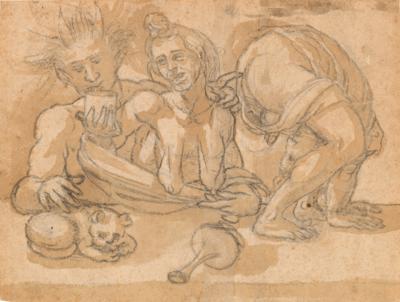Amico Aspertini

(Bologna um 1475–1552) Grotesque genre scene, presumably an illustration for a popular proverb (recto);
The Transport of the Body of Saint Christopher (verso), black chalk, brown wash, on laid paper, 19 x 24,5 cm, inscribed “Amico Aspertino” and “Aspertino” on the reverse and several numbers and letters, browned, foxing, mounted, unframed, (Sch)
Provenance:
Georg Wilhelm Denzel (1873–1959), not with Lugt;
Auction Sotheby’s, New York, 27th January 2021, lot 11;
Private collection, Italy.
The attribution to Amico Aspertini was confirmed by Prof. Alessandro Zacchi by means of a high-resolution digital photograph.
Amico Aspertini came from a family of artists in Bologna and in his early years was active as an assistant in the workshops of Ercole Roberti, Lorenzo Costa and Francesco Francia. During an early trip to Florence he probably also met Filippino Lippi (1457-1508), whose painting had a great influence on the young artist. Between 1496 and 1503 Aspertini was active in Rome and he may also have spent some time in Lucca, Siena und Mantua. Rome, however remained an important place of activity for the artist to which he also returned in later years between 1527 and 1528 and from 1531 to 1534. Stylistically, the present drawing is likely to be from Amico Aspertini’s late work between 1530 and 1540. The recto is showing a grotesque “genre scene”, which is probably an illustration of a proverb or a folk tale, which is typical of the artist’s graphic work of that time. The adoption of popular pictorial content and the depiction of comic and bizzare aspects of daily life also exerted a great influence on Bartolomeo Passerotti (1529-1592), a tendency which is particularly visible in Passerotti’s pen and ink drawings (cf. Marzia Faietti, „nato per intagliare“? Le opinioni di Malvasia e le penne di Passerotti, in: Il pittore, il poeta e i pidocchi. Bartolomeo Passerotti e l’“Omero” di Giovan Battista Deti, Livorno 2021, pp. 152-183). The reverse of the present sheet is stylistically more difficult to classify because of its poor state of preservation;
but it may be thematically related to a drawing from the so-called „Aspertini-Album II“ in the British Museum (Inv. No 1862,0712.406, fol. 13 recto, No 25) which has a vertical format and shows “The Transport of the Body of Saint Christopher.” The London drawing is based on the right half of Mantegna’s fresco of St. Christopher in the Ovetari chapel (c. 1450-56) in the church of the Eremitani in Padua. Whereas in the London drawing the main scene is integrated into the architecture of the background, in the present drawing Aspertini concentrated mainly on the figures in the composition and the architecture in the background appears only vaguely suggested. For this scene and other comparable drawings from the sketch albums in the British Museum, see: P. P. Bober, Drawings after the Antique by Amico Aspertini. Sketchbooks in the British Museum“, London 1957;
M. Faietti, D. Scaglietti Kelescian, “Amico Aspertini”, Modena 1995, p. 68, fig. 51;
Cat. 96, pp. 310-11. The present drawing represents an important addition to the graphic oeuvre of Amico Aspertini. It is a significant testimony to the artistic diversity of his expressive possibilities and the great influence which he exerted on the following generation of artists in Bologna by depicting grotesque genre and everyday scenes and conveying content from popular culture.
Specialist: Mag. Astrid-Christina Schierz
 Mag. Astrid-Christina Schierz
Mag. Astrid-Christina Schierz
+43-1-515 60-546
astrid.schierz@dorotheum.at
20.04.2022 - 15:50
- Realized price: **
-
EUR 5,120.-
- Estimate:
-
EUR 4,000.- to EUR 6,000.-
- Starting bid:
-
EUR 4,000.-
Amico Aspertini
(Bologna um 1475–1552) Grotesque genre scene, presumably an illustration for a popular proverb (recto);
The Transport of the Body of Saint Christopher (verso), black chalk, brown wash, on laid paper, 19 x 24,5 cm, inscribed “Amico Aspertino” and “Aspertino” on the reverse and several numbers and letters, browned, foxing, mounted, unframed, (Sch)
Provenance:
Georg Wilhelm Denzel (1873–1959), not with Lugt;
Auction Sotheby’s, New York, 27th January 2021, lot 11;
Private collection, Italy.
The attribution to Amico Aspertini was confirmed by Prof. Alessandro Zacchi by means of a high-resolution digital photograph.
Amico Aspertini came from a family of artists in Bologna and in his early years was active as an assistant in the workshops of Ercole Roberti, Lorenzo Costa and Francesco Francia. During an early trip to Florence he probably also met Filippino Lippi (1457-1508), whose painting had a great influence on the young artist. Between 1496 and 1503 Aspertini was active in Rome and he may also have spent some time in Lucca, Siena und Mantua. Rome, however remained an important place of activity for the artist to which he also returned in later years between 1527 and 1528 and from 1531 to 1534. Stylistically, the present drawing is likely to be from Amico Aspertini’s late work between 1530 and 1540. The recto is showing a grotesque “genre scene”, which is probably an illustration of a proverb or a folk tale, which is typical of the artist’s graphic work of that time. The adoption of popular pictorial content and the depiction of comic and bizzare aspects of daily life also exerted a great influence on Bartolomeo Passerotti (1529-1592), a tendency which is particularly visible in Passerotti’s pen and ink drawings (cf. Marzia Faietti, „nato per intagliare“? Le opinioni di Malvasia e le penne di Passerotti, in: Il pittore, il poeta e i pidocchi. Bartolomeo Passerotti e l’“Omero” di Giovan Battista Deti, Livorno 2021, pp. 152-183). The reverse of the present sheet is stylistically more difficult to classify because of its poor state of preservation;
but it may be thematically related to a drawing from the so-called „Aspertini-Album II“ in the British Museum (Inv. No 1862,0712.406, fol. 13 recto, No 25) which has a vertical format and shows “The Transport of the Body of Saint Christopher.” The London drawing is based on the right half of Mantegna’s fresco of St. Christopher in the Ovetari chapel (c. 1450-56) in the church of the Eremitani in Padua. Whereas in the London drawing the main scene is integrated into the architecture of the background, in the present drawing Aspertini concentrated mainly on the figures in the composition and the architecture in the background appears only vaguely suggested. For this scene and other comparable drawings from the sketch albums in the British Museum, see: P. P. Bober, Drawings after the Antique by Amico Aspertini. Sketchbooks in the British Museum“, London 1957;
M. Faietti, D. Scaglietti Kelescian, “Amico Aspertini”, Modena 1995, p. 68, fig. 51;
Cat. 96, pp. 310-11. The present drawing represents an important addition to the graphic oeuvre of Amico Aspertini. It is a significant testimony to the artistic diversity of his expressive possibilities and the great influence which he exerted on the following generation of artists in Bologna by depicting grotesque genre and everyday scenes and conveying content from popular culture.
Specialist: Mag. Astrid-Christina Schierz
 Mag. Astrid-Christina Schierz
Mag. Astrid-Christina Schierz
+43-1-515 60-546
astrid.schierz@dorotheum.at
|
Buyers hotline
Mon.-Fri.: 10.00am - 5.00pm
kundendienst@dorotheum.at +43 1 515 60 200 |
| Auction: | Master Drawings, Prints before 1900, Watercolours, Miniatures |
| Auction type: | Online auction |
| Date: | 20.04.2022 - 15:50 |
| Location: | Vienna | Palais Dorotheum |
| Exhibition: | 13.04. - 20.04.2022 |
** Purchase price excl. charges and taxes
It is not possible to turn in online buying orders anymore. The auction is in preparation or has been executed already.
